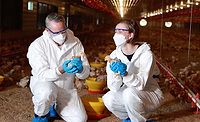Birds may be the most difficult of all pests to control in the food industry, yet the need to control them is essential for food safety and audit compliance. Birds, including their droppings, feathers, and nesting materials, carry about 60 different pathogens of concern to product and worker safety. Bird droppings present slip and fall hazards, and can be corrosive. Nesting materials can clog equipment air intakes and exhausts. Needless to say, auditors do not want to see birds or bird filth. Compared to other pests, birds have unique mobility, vision, and intelligence. Bird control is complicated by human sympathies and affection for birds. The general public, or even some employees, will probably not tolerate seeing birds in distress, injured, or killed. However, most control methods are non-lethal.
The Problem for Food Processors
The fundamental requirements that birds have are the same as other pests: food, water, and harborage. Many food processing facilities offer all three in abundance, as well as other factors that can attract birds, including:
- Spillage of grain, flour, or other ingredients from the rooftop all the way down to surrounding grounds
- Very tall structures, such as grain elevators or towering buildings, that naturally appeal to cliff-dwelling birds like pigeons
- Covered roof areas with good exposures for flocking birds to find sun or shade
The most conducive condition for a bird infestation may be cavities for nesting in the corrugations of roofing materials and other areas. Bird situations can develop over time, so an issue may take years to fully develop. For example, if a few birds found places to nest years ago without much notice or concern, it could become an ancestral rookery for a colony of birds, in addition to all the other attractions that may be provided. One of the most difficult pest issues to overcome is the attachment of birds to a nesting site.
Customizable Solutions for Your Facility
A bird specialist is usually required to analyze the attractive features and how birds are using a site (assessment of bird pressure or bird attachment to the site) to determine the best course of action. Once an assessment is completed, there are 100 or more fairly distinct devices or methods for bird control. Although no single device or method can guarantee success, often a few carefully selected tactics will be effective in combination. The level of bird pressure will dictate the best selections. There are also differences in behavior among the common pest birds, and the susceptibility of the target species to a device or method needs consideration, as well. When bird control is needed, you should look for a specialist with the capabilities to analyze a food plant situation and make reasonable recommendations that are achievable through a food plant and pest control provider partnership, and that has the ability to take on the scale of installation work that may be necessary.
Categories of Bird Control Methods and Devices
- Chemical controls: Avicides (pesticides), baits, harassment chemicals, and repellents
- Physical controls: Visual and audio scare devices, trapping, and exclusion devices
When an Outdoor Problem Comes Indoors
Almost every building is susceptible to an occasional bird flying in through an open door. Susceptibility increases with multiple doors and becomes even more of a risk with dock doors. Indoor birds are an immediate food safety hazard or risk for finished product rejection if droppings are found on product. Since susceptibility is universal, every facility should have an emergency plan for dealing with indoor birds. Here are some immediate actions that should be taken:
- Attend to the most critical food safety risks. Exclude the bird from entering the most critical processing areas where products are exposed. Be prepared to cover critical lines and equipment quickly.
- Try to allow the bird to fly out. Consider darkening the space and giving the bird an open-door opportunity. Try coordinating a crew of people to herd the bird toward an opening with flashlights or laser pointers. Birds will be drawn to the light of an open window or door in a dark area.
- Be prepared with some equipment for fast trapping of indoor birds. Indoor birds often fall into the same patterns of flying; certain racetrack patterns or alleyways, or certain roosting spots are used repeatedly. Mist nets—very fine nets shaped like oversized volleyball nets that are invisible to birds—can be put up in flyways very quickly to entrap flying birds.
Bird control is an important ingredient in the recipe of integrated pest management for food processing facilities. Birds can cause a myriad of issues and are difficult to control, so it is imperative that you work with your provider to develop a comprehensive, proactive plan for dealing with these destructive pests. When there is a plan in place and your staff is aware of the procedures and protocols, your team will be a unified force against all pests, and especially birds.
For more information, visit www.indfumco.com or call 800-477-4432.





